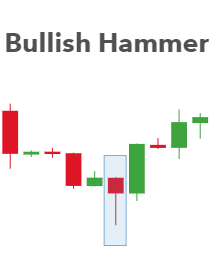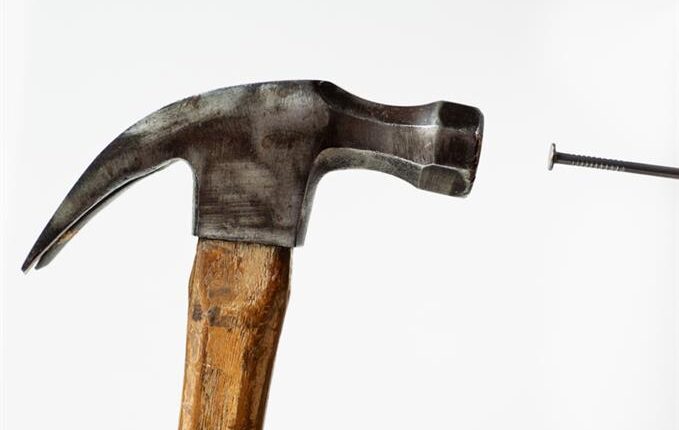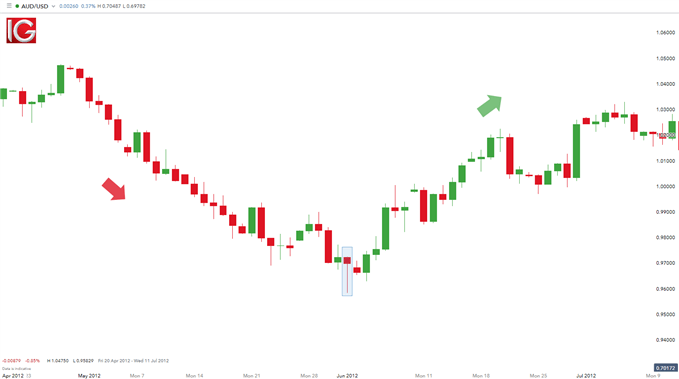Trading the Bullish Hammer Candle

– Reviewed by James Stanley, Nov. 24, 2021
The Bullish Hammer Candlestick Pattern: Main Talking Points
The bullish hammer candlestick pattern is frequently observed in financial markets and, like many Japanese candlesticks, provides important insight into market momentum. In particular, the bullish hammer can help to validate a chart’s reversal point.
Traders can exploit the detection of a bullish hammer candle with a proper understanding of its foundations. This article will outline the following:
- What is a bullish hammer?
- Using a Bullish Hammer Candlestick Pattern in Trading
- Further Reading on Trading with Candlestick Patterns
What is a bullish hammer?
A bullish hammer is a single candle found within a price chart indicating a bullish reversal. It differs from other candlestick patterns due to its single candle hinting at a turn during an established downtrend.
Pictured below the hammer is interpreted by understanding a candles particular open, low high and close levels. To create a hammer, price must first significantly sell off to create a new low for a currency pair. However, after this decline, prices must significantly rally causing prices to have a small body and close near its opening price.

It’s important to remember that bullish hammers should have long wicks at least twice the length of the candle body. In addition, the candle itself can either be red or green depending on the strength of the reversal.
Often the bullish hammer is confused with a bearish hanging man candle. The misrepresentation is logical because both candles look identical. The difference between these two candles lies in their placement in a trending market. The hanging man has a small body and long wick but is found hanging at the end of an uptrend. Bullish hammers have small bodies and long wicks also but are only seen at the end of a downtrend.
How to spot a Bullish Hammer pattern:
- Candle with a short body and long wick (at least 2x the size of the body)
- Occurs at the bottom of a downward trend
- Confirmation from other indicators as mentioned below
What does it indicate:
- Trend reversal to the upside (bullish reversal)
- Price rejection at a certain ‘key level’
Value to traders:
- Indicates potential price reversals which could lead to entering a long position at the start of an upward swing – capitalize on the full upward movement
- Easy to identify
Using a Bullish Hammer Candlestick Pattern in Trading
Bullish hammer candlestick in the forex market
Bullish hammer candles can be found on a variety of charts and time frames. Depicted above is an example of the hammer on the AUD/USD daily chart. From 20 April through to 31 May the AUD/USD fell as much as 892 pips. This downtrend was concluded with a bullish hammer candle, and price has subsequently rallied a total of 792 pips through today’s price action.
AUD/USD Bullish Hammer candlestick:
As the strength of a hammer depends on its placement on the graph, normally traders use this candle in conjuncture with other indications of price support. This includes using tools such as Fibonacci retracements, pivot points and psychological whole numbers. In an ideal scenario, the wick of the hammer will penetrate a support level, but the body will close above support on renewed buying sentiment. With a new buying opportunity presented, traders may then choose to place stops under the created wick below support.
Bullish hammer candlestick in the equity market
The bullish hammer candle is interpreted the same way in all financial markets (indices, forex, commodities and stocks) however, stock analysis requires further data as confirmation. It is important to note that brokers generally show internal volume figures for the other financial markets including forex which is why the volume indicator is not reliable for an overall market volume estimate.
The chart below shows a bullish hammer candle on a Barclays PLC chart. In conjunction with the bullish hammer, there is a subsequent relative increase in volume traded as highlighted. This emphasizes institutional activity for this period due to the large volume – retail traders will not be able to affect such large volumes.
This ‘denial’ by bulls (traders taking long positions) after the recent swing low displays price rejection at that level. This level may be a key level whereby ‘buy’ order are triggered. With the bullish hammer and the volume exhibit this relationship, traders can have some form of validation to place a long trade. As always, the principals of risk management should apply to all trades.
Barclays PLC Bullish Hammer:

Further Reading on Trading with Candlestick Patterns
The bullish hammer candle is one of many bullish price patterns that can assist traders when entering a trade. Other bullish patterns traders should be aware of, include: morning star and the inverse head and shoulders among others.
Day traders, however, incorporate the use of indicators and key levels of support and resistance, alongside candlesticks, to substantiate trades before entering. Other aides you can use to improve your trading include our free trading guides and for those just getting started, take a look at our New to FX guide.



Comments are closed.